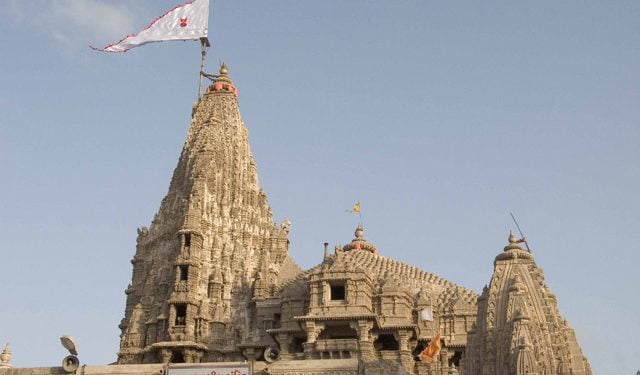Dwarkadhish temple, also known as the Jagat Mandir and occasionally spelt Dwarakadheesh , is a Hindu temple dedicated to the god Krishna, who is worshipped here by the name Dwarkadhish, or ‘King of Dwarka’
Shrine’s History
Dwarka is steeped in myths. It was known by the name of Kushasthali in ancient times. Being the most important center on the Saurashtra coast, it is deemed that after slaughtering Kansa, Dwarakadeesh left his home in Mathura. Lord Krishna moved with his complete Yadava community and arrived at the Saurashtra coast and discovered a place called Swarandwarika. As per the legends, when he was breathing his last breath, Lord Krishna requested his followers to get away from Swarnadwarika because it could be swallow up by the sea. After the death also, the city soaked in the water, destroying the whole Yadav family. Excavations have shown that the presence of well-planned spots on the coasts of the River Gomati, bestowing evidence of this celebrated faith.
The town of Dwarka in Gujarat has a history that dates back centuries, and mentioned in the Mahabharat epic as the Dwaraka Kingdom. Situated on the banks of river Gomti, the town is described in legend as the capital of Lord Krishna. Evidence such as a stone block with script, the way the stones were dressed showing that dowels had been used, and an examination of anchors found on the site suggest that the harbour site dates only to historical times, with some of the underwater structure being late Medieval. Coastal erosion was probably the cause of the destruction of what was an ancient port. Hindus believe that the original temple was constructed by Vajranabh, the great grand son of Krishna, over the residential palace of Krishna.
Legends Associated with This Shrine
There is a legend behind the idol of Lord Dwarkadhish in the temple. Badana, an old devotee, used to come daily from Dakor to Dwarka, in order to have a glimpse of the Lord Dwarkadhish. The Lord was really appeased with her and one day, he went along with Badana to Dakor, in the form of idol. The priests at Dwarka temple got angry at Badana, who took the idol according to them. The enraged priests chased Badana to get back the idol. Badana convinced the priests to leave the idol instead of gold. The priests agreed upon the condition and to their surprise, the idol happened to be as light as one nose-ring. This miracle was done by the Lord himself, as he knew Badana had only a nose-ring to offer. However, the Lord didn’t disappoint the priests and said that they would find a replica on a particular day. The priests could not resist their inquisitiveness and excavated the recommended site quite early. They found one yet to grow idol that is presently enshrined at Dwarka.
Architectural Relevance of This Shrine
The main shrine of the 5-storied building, supported by 72 pillars, is known as Jagat Mandir or Nija Mandir, archaeological findings suggest it to be 2,200 – 2,000 years old. Temple was enlarged in the 15th- 16th century.
The current temple in Chalukya style is constructed in 15-16th century. The temple covers area of 27 metre by 21 metre with east-west length of 29 metre and north-south width of 23 metres. The tallest peak of the temple is 51.8 m high.
According to tradition, the original temple was believed to have been built by Krishna’s grandson, Vajranabha, over the hari-griha (Lord Krishna’s residential place).
Shrine’s Map Location and How to Go There
By Road
Dwarka is easily accessible by road from the following destinations:Ahmedabad – 481kms Rajkot – 217 km Gandhinagar – 481 km Jamnagar – 148 kms
By Rail
Dwarka is nestled on the Ahmedabad-Okha rail route connecting to the other main railheads.
By Air
There are no regular flights from other major cities of the country to Dwarka. Nearest airport is Porbandar Airport. Dwarka 95 km away Porbandar Airport (PBD), Porbandar, Gujarat Dwarka 110 km away Govardhanpur Airport (JGA), Jamnagar, Gujarat Search Flights
Shrine Timings
Morning 7:00 Mangla Aarti; 7:00 to 8:00 Mangla Darshan; 8:00 to 9:00 Abhishek Pooja …
Extra Information About this Shrine
The temple became part of the Char Dham pilgrimage considered sacred by Hindus in India, after Adi Shankaracharya, the 8th century Hindu theologian and philosopher, visited the shrine. The other three being comprising Shringeri, Badrkashram and Puri. Even today a memorial within the temple is dedicated to his visit. Dwarakadheesh is one the 108th Divya Desams of Lord Vishnu on the subcontinent, glorified in the Divya Prabandha sacred texts.
The Dwarkadhish Temple is a Pushtimarg temple, hence it follows the guidelines and rituals created by Shree Vallabhacharya and Shree Vitheleshnathji.













































